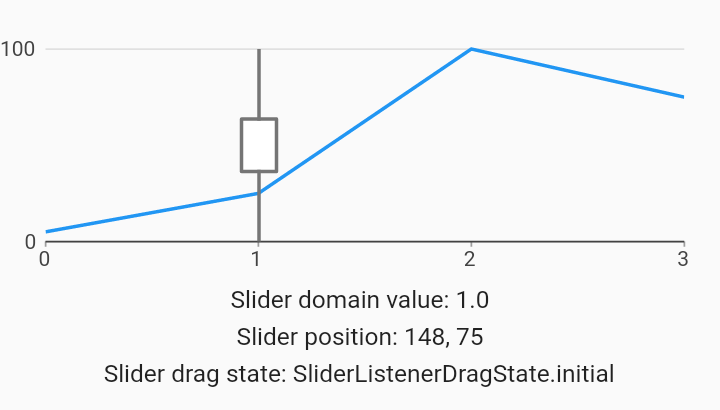charts
Slider Behaviors Example

Example:
import 'dart:math';
// EXCLUDE_FROM_GALLERY_DOCS_END
import 'package:charts_flutter/flutter.dart' as charts;
import 'package:flutter/material.dart';
import 'package:flutter/rendering.dart';
import 'package:flutter/scheduler.dart';
/// This is just a simple line chart with a behavior that adds slider controls.
///
/// A [Slider] behavior is added manually to enable slider controls, with an
/// initial position at 1 along the domain axis.
///
/// An onChange event handler has been configured to demonstrate updating a div
/// with data from the slider's current position. An "initial" drag state event
/// will be fired when the chart is drawn because an initial domain value is
/// set.
///
/// [Slider.moveSliderToDomain] can be called to programmatically position the
/// slider. This is useful for synchronizing the slider with external elements.
class SliderLine extends StatefulWidget {
final List<charts.Series> seriesList;
final bool animate;
SliderLine(this.seriesList, {this.animate});
/// Creates a [LineChart] with sample data and no transition.
factory SliderLine.withSampleData() {
return new SliderLine(
_createSampleData(),
// Disable animations for image tests.
animate: false,
);
}
// We need a Stateful widget to build the selection details with the current
// selection as the state.
@override
State<StatefulWidget> createState() => new _SliderCallbackState();
/// Create one series with sample hard coded data.
static List<charts.Series<LinearSales, int>> _createSampleData() {
final data = [
new LinearSales(0, 5),
new LinearSales(1, 25),
new LinearSales(2, 100),
new LinearSales(3, 75),
];
return [
new charts.Series<LinearSales, int>(
id: 'Sales',
domainFn: (LinearSales sales, _) => sales.year,
measureFn: (LinearSales sales, _) => sales.sales,
data: data,
)
];
}
}
class _SliderCallbackState extends State<SliderLine> {
num _sliderDomainValue;
String _sliderDragState;
Point<int> _sliderPosition;
// Handles callbacks when the user drags the slider.
_onSliderChange(Point<int> point, dynamic domain, String roleId,
charts.SliderListenerDragState dragState) {
// Request a build.
void rebuild(_) {
setState(() {
_sliderDomainValue = (domain * 10).round() / 10;
_sliderDragState = dragState.toString();
_sliderPosition = point;
});
}
SchedulerBinding.instance.addPostFrameCallback(rebuild);
}
@override
Widget build(BuildContext context) {
// The children consist of a Chart and Text widgets below to hold the info.
final children = <Widget>[
new SizedBox(
height: 150.0,
child: new charts.LineChart(
widget.seriesList,
animate: widget.animate,
// Configures a [Slider] behavior.
//
// Available options include:
//
// [eventTrigger] configures the type of mouse gesture that controls
// the slider.
//
// [handleRenderer] draws a handle for the slider. Defaults to a
// rectangle.
//
// [initialDomainValue] sets the initial position of the slider in
// domain units. The default is the center of the chart.
//
// [onChangeCallback] will be called when the position of the slider
// changes during a drag event.
//
// [roleId] optional custom role ID for the slider. This can be used to
// allow multiple [Slider] behaviors on the same chart. Normally, there can
// only be one slider (per event trigger type) on a chart. This setting
// allows for configuring multiple independent sliders.
//
// [snapToDatum] configures the slider to snap snap onto the nearest
// datum (by domain distance) when dragged. By default, the slider
// can be positioned anywhere along the domain axis.
//
// [style] takes in a [SliderStyle] configuration object, and
// configures the color and sizing of the slider line and handle.
behaviors: [
new charts.Slider(
initialDomainValue: 1.0, onChangeCallback: _onSliderChange),
],
)),
];
// If there is a slider change event, then include the details.
if (_sliderDomainValue != null) {
children.add(new Padding(
padding: new EdgeInsets.only(top: 5.0),
child: new Text('Slider domain value: ${_sliderDomainValue}')));
}
if (_sliderPosition != null) {
children.add(new Padding(
padding: new EdgeInsets.only(top: 5.0),
child: new Text(
'Slider position: ${_sliderPosition.x}, ${_sliderPosition.y}')));
}
if (_sliderDragState != null) {
children.add(new Padding(
padding: new EdgeInsets.only(top: 5.0),
child: new Text('Slider drag state: ${_sliderDragState}')));
}
return new Column(children: children);
}
}
/// Sample linear data type.
class LinearSales {
final int year;
final int sales;
LinearSales(this.year, this.sales);
}